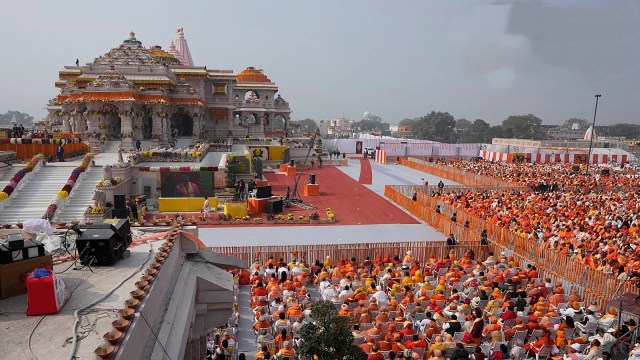No Design Issue: Ram Temple Panel Refutes Claims of Leakage

Soon after the grand inauguration ceremony held in Ayodhya, the Ram Mandir faced unexpected issues as the head priest, Acharya Satyendra Das, reported that the temple’s roof began leaking following heavy rainfall. He expressed his surprise, noting that despite the presence of many engineers and the recent ‘Pran Pratishtha’ ceremony on January 22, water was leaking from the roof, highlighting a lack of proper drainage.
The ‘Pran Pratishtha’ ceremony, during which Prime Minister Narendra Modi performed the main rituals, marked the unveiling of the idol of Ram Lalla. However, the temple’s exposure to the sky has been identified as the primary cause of the leakage issue. According to the committee members, this problem is expected to be resolved with the completion of the Shikhar.
In response to the allegations of water leakage, Sri Ram Mandir Construction Committee Chairman, Nripendra Mishra, provided clarification. Mishra, who was in Ayodhya, observed rainwater dropping from the first floor, attributing it to the incomplete construction of the Guru Mandap, which is currently exposed to the sky. He explained that once the Shikhar is completed, it will cover this opening, preventing such issues. Mishra also mentioned seepage from the conduit, stating that this is a temporary problem that will be addressed once the first-floor work is completed. He assured that there are no design or construction flaws, as the Mandaps have a measured slope for water clearance, and any water in the Sanctum Santorum is manually absorbed. Additionally, devotees are not performing Abhishek on the deity, further reducing the risk of water damage. The open Mandaps, which may receive rainwater, were deliberately designed this way according to Nagar architectural norms.
Mishra also provided updates on the ongoing construction projects related to the temple. He informed that work on the Ram Katha Sangrahalaya has commenced, and a guest house is being constructed to ensure the convenience of saints and seers. The committee is working towards completing the temple construction by December 2024. He also mentioned plans for constructing an auditorium, with foundation laying scheduled for July and completion expected within a year.
According to the Ministry of Tourism, Ayodhya has become a significant religious tourism destination, with over 1.5 crore visitors since the consecration ceremony. The government of Uttar Pradesh is promoting a new golden triangle of religious tourism, comprising Prayagraj, Kashi (Varanasi), and Ayodhya. Last year, Varanasi alone attracted 8.5 crore tourists, while Prayagraj saw around 4.5 crore visitors. Many experts believe that Varanasi will surpass other popular tourist destinations like Goa, Agra, and Shimla in terms of visitor numbers.
Also Read| CBI Registers FIR for Alleged Irregularities in NEET-UG Exam
Author:- Apoorva Arora
